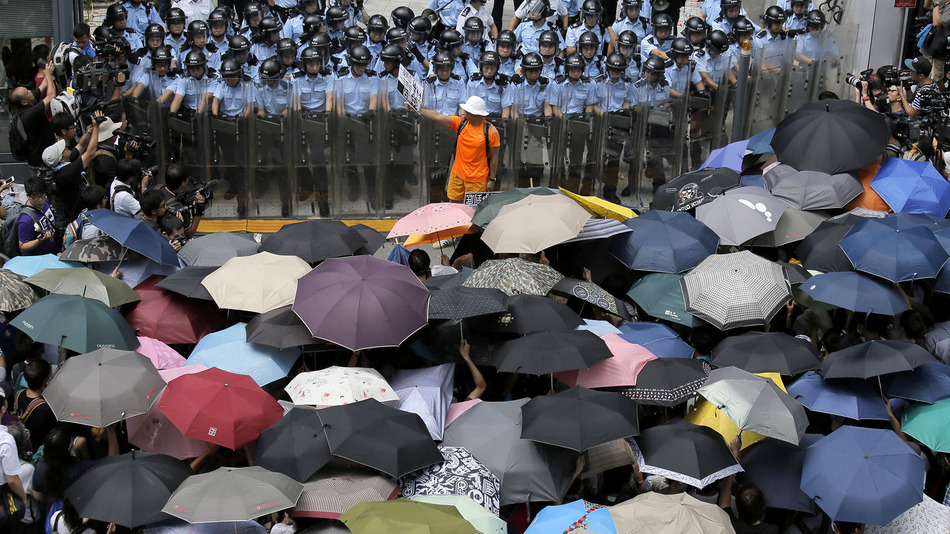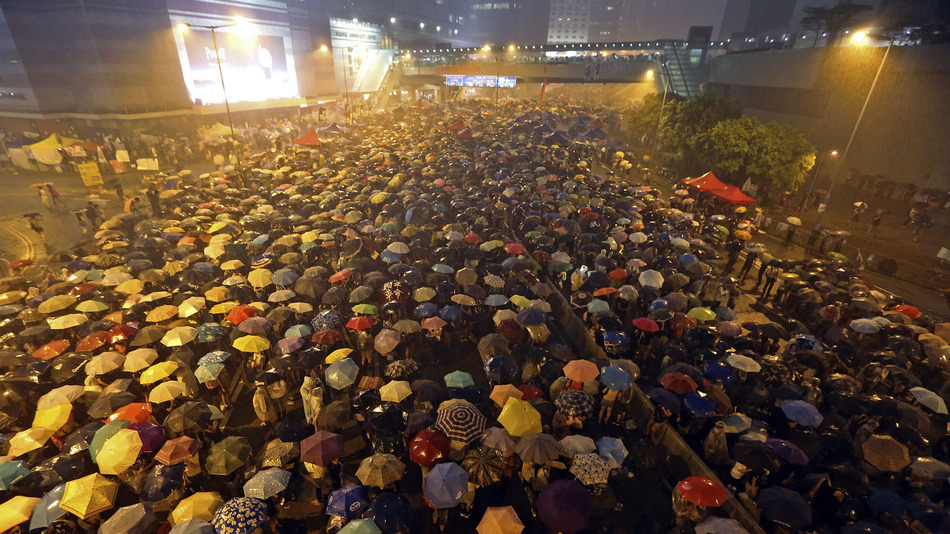The Umbrella Revolution
By Mercedes Mack
Some historical and strategic nonviolent context of what is now called the Umbrella Revolution-Hong Kong’s demand for democracy.
Outside government headquarters, a protestor raised a sign reading “Occupy Central”
Brief History of Democratization Demands in Hong Kong
Protests in Hong Kong have been occurring on and off since June 2003 when 500,000 protesters marched against Article 23, a proposed law affecting national security. Students objected because this law, aimed at enacting legislation restricting activities of “political organizations or bodies” against the Central People’s Government, but students felt this law was really aimed at preventing organized dissent and an attempt to prevent any anti-China opposition. Protests were successful and the law was not passed. In April of 2004, 15,000 people marched in protest against China’s declaration that there would be no direct election of Hong Kong’s head of government. After another protest in December of 2007, China promised a timeline for direct elections in Hong Kong-direct votes of Chief Executive in 2017, and all its lawmakers by 2020.
The Umbrella Revolution
Recent protests have been in response to China’s increasing authoritative measures on Hong Kong’s autonomy. In July, the People’s Republic of China released a “White Paper” to Hong Kong reaffirming its “power to run local affairs as authorized by central leadership” , i.e. the People’s Republic of China, by mandating that all candidates in Hong Kong’s election be vetted by a nomination committee set up by the People’s Republic of China.
In July of 2014, hundreds of thousands of people marched and then sat-in overnight demanding direct elections. On September 22, 2014, thousands of university students, part of the Scholarism movement, coordinated protests and massive sit-ins in key government and financial districts in the city.
Protests started again on Sunday Sept 28 as mostly student protestors blocked streets and rallied in front of government buildings. The protests have continued despite police response with tear gas and rubber bullets. Occupy Central with Love and Peace, the local Occupy, had scheduled a massive protest for Oct 1, a national holiday to celebrate the People’s Republic of China, but instead joined the student protests in solidarity.
Aspects of Strategic Nonviolence in the Umbrella Revolution
The Umbrella Revolution seems to be an organized nonviolent movement with much promise. Members are prepared and disciplined as well as diverse-different age groups, socio-economic status, gender,and religion. Movement organizers prepared for a police response with tear gas, and instructing protesters to wear goggles, and bring umbrellas (what has become iconic to the movement) to protect against the streams of tear gas. All reports indicate that protests have maintained nonviolence, even in the face of police resistance. There are sit- ins and sleep- ins in strategic financial and governmental locations in Hong Kong. There is also some constructive programming occurring within the student facet of the movement. Students have created their own lesson plans during the movement under the slogan “boycott classes and keep learning”. Organizers have created open and mobile classrooms, libraries and introduced public lectures by academics.
Protestors in Hong Kong during a rainstorm on Tuesday, Sept 30, 2014
Deliberately or not, the movement seems decentralized, lacking a single charismatic leader. The Umbrella Revolution is largely associated with Occupy Central with Love and Peace, a local Occupy movement started by Benny Tai Yiu-ting, an associate professor of law at the University of Hong Kong in January 2013 with a specific directive instructing protesters to block roads and paralyze Hong Kong’s financial district to demand democracy in Hong Kong. Tai Yiu-ting and several other co-leaders in the movement have created a nonviolent directive for Occupy based on the activism of Mahatma Gandhi and Martin Luther King Jr. Another prominent group associated with the Umbrella Revolution is the student group Scholarism led by Joshua Wong Chi-fung.
In a recent NYTimes video titled Scenes of Chaos in Hong Kong, a protester commented in reaction to police destruction of tents, “They tried to remove this tent, we think this is our last place to go. If this place falls, we all fall”. In this sense, the act of occupying downtown Hong Kong, ie the tents, have become a symbol of the movement. To believe that the movement will fail if it is driven out of the downtown is not only wrong, but dangerous to the survival of the movement. Michael Nagler comments on the danger of clinging to symbols and draws a comparison to the Tienanmen Square demonstrations in 1989. In essence once the movement was driven out of the square, it ended. Nonviolent movements are much more than an occupation or demonstration. To channel the movement’s energy outside occupation of the downtown area and maintain pressure on government, the movement must diversify its tactics. This could include the implementation of constructive programs, education of the public, and lightening protests.
The Umbrella Revolution has put caught The People’s Republic of China by what’s called a dilemma action-—they can either brutally squash the protests and risk de-legitimizing their government or acquiesce to protestors’ demands and potentially open the doors for protest within the People’s Republic of China; which is exactly where Hong Kong wants them to be.
For more information about the various groups associated with the Umbrella Revolution see: Who Guides Hong Kong’s “Umbrella Revolution” pro democracy movement?
For a map of the Areas of Protest, see the NY Times website.
For a great synopsis of the Umbrella Revolution, check out: Everything You Need To Know About Hong Kong’s Umbrella Revolution.
See NYTimes Images of Hong Kong’s Umbrella Revolution.










